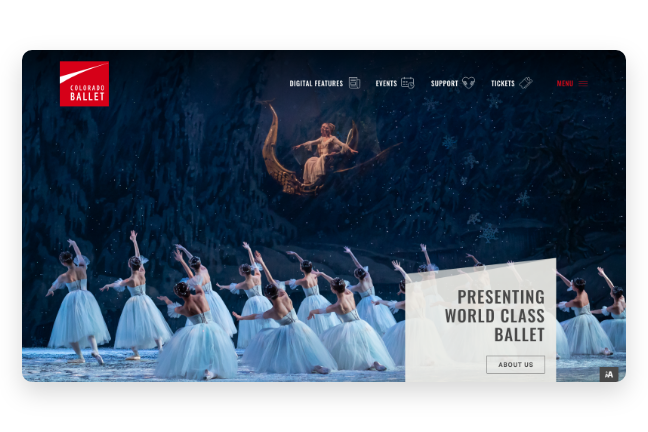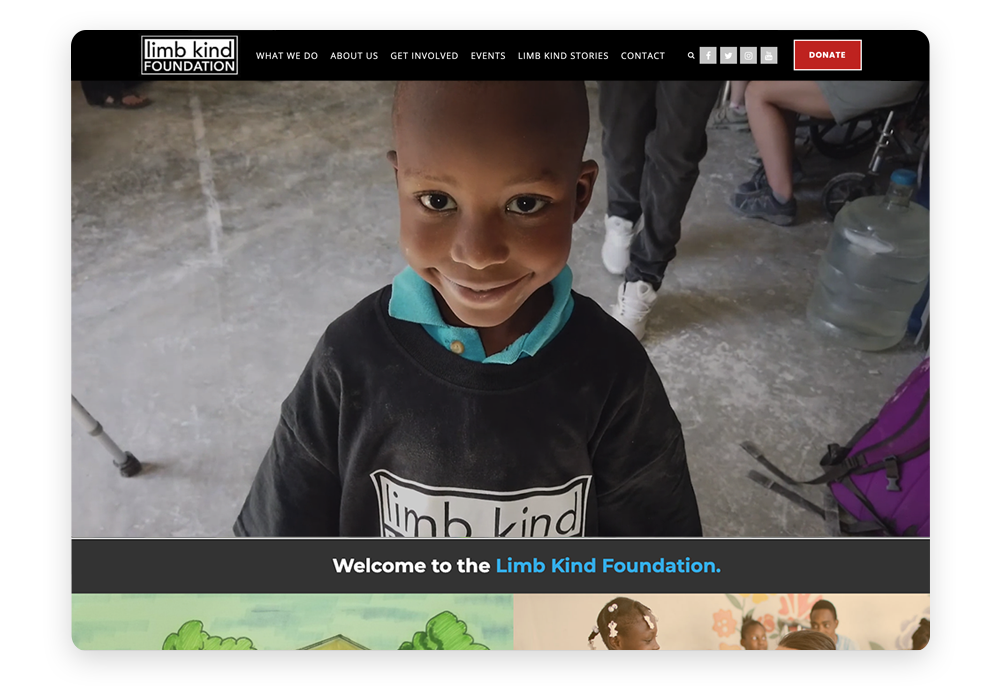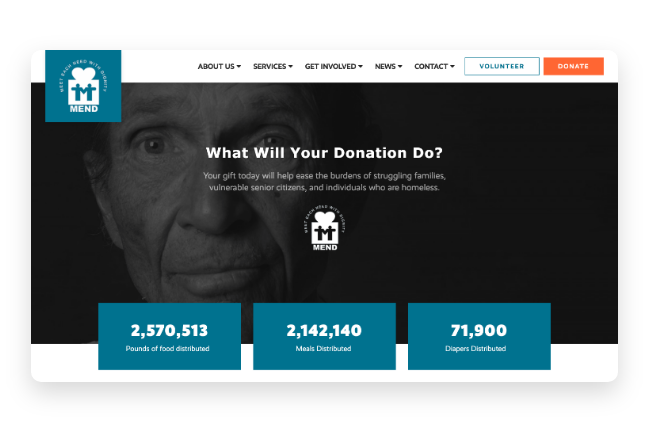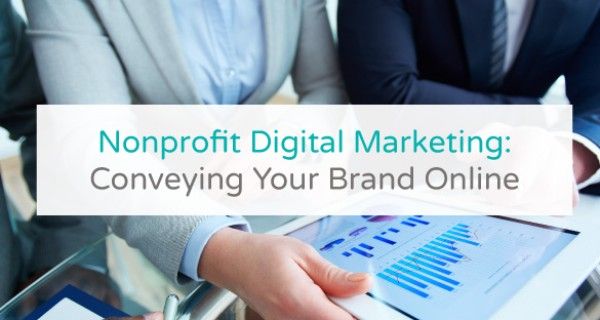Digital Marketing: Conveying Your Nonprofit's Brand Online

The nonprofit world has changed dramatically since the beginning of the COVID-19 pandemic in 2020. By necessity, fundraising professionals like you have learned to adapt to this digital age to navigate the complexities of these unprecedented times. You’ve leveraged technology to host hybrid and virtual fundraising events, carried out lucrative online campaigns, and worked hard to maintain strong donor relationships despite being unable to interact with your community face-to-face.
The pandemic has shown us why having a solid online presence is essential to any nonprofit’s success. Digital marketing enables your organization to quickly raise awareness for your mission and continue to grow your foundation of support even during a time when we can’t physically be together. Having an online presence is paramount for organizations of all sizes, but getting started or boosting your existing efforts can be difficult — especially if you’re a full-time fundraiser who has little-to-no experience in web design and other digital marketing strategies.
But before you can dive into tasks like revamping your website or optimizing your content for search engines, you have to start by creating a nonprofit digital marketing strategy. You should start by defining how your organization stands out from the rest — your brand. Once you know your brand, you can use it to increase and improve your online presence. To help, we’ve created this guide to conveying your brand online. In it, we’ll cover the following steps:
- Define your brand.
- Lean into storytelling.
- Use impactful visuals.
- Brand your donation page.
- Leverage social media.
- Remember that consistency is key.
Creating a nonprofit digital marketing strategy can certainly seem intimidating. However, you can streamline the process and effectively convey your brand by following these steps and using the right technology.
One critical tool you’ll need is a nonprofit-specific website builder or content management system (CMS). A website builder created for nonprofits can help you easily design a great website, which can in turn help you begin building your brand online. Morweb’s guide to nonprofit website builders can help you explore your options.
Once you have the tools to support your vision, you can start bringing your mission to life online. Let’s dive in!
1. Define your brand.

The word “brand” can make many nonprofit professionals pause. After all, the idea of branding feels very abstract and hard to pin down. But the truth is, even if you can’t put your finger on what your organization’s brand is, you already have one!
Your brand is everything that helps your nonprofit stand out from other organizations. It’s what your community remembers about your organization after hearing about it or interacting with your team. This includes obvious things like what your mission is and who your beneficiaries are, but it also includes how you talk about your mission and treat your donors and volunteers.
This less tangible aspect of your brand will be critical for guiding how you interact with your audience online. But the visual aspect of your brand will also play a large role in your digital marketing strategy.
Your visual brand includes the following elements:
Colors. Colors can establish the general mood of a web page or social media post. For example, a bright yellow web page will convey energy, positivity, and cheer, while a subtle green might evoke mental images of nature and establish a relaxing mood.
Logos and slogans. Your logo is a shorthand visual representation of your organization. If your organization is dedicated to elephant conservation, for example, it would be natural to have a logo that included the form of an elephant. A nonprofit slogan differs from a logo in that it is a written message or phrase that conveys what your organization’s core work is all about. For the elephant conservation example, a potential slogan might be “Stopping elephant poaching in its tracks since 1999.”
Typography. The look of the words on your website or in your email newsletter also convey what your brand is. Your chosen font, text size, color, and even kerning (the space between individual letters) all contribute to the overall mood of your marketing materials and messages.
Imagery. The photos, graphics, and illustrations you use online play a huge role in establishing your organization’s brand. Sticking to only black-and-white pictures, for example, will create a certain impression for website visitors, whereas only using colorful images will create another impression entirely.
Clearly there is a lot that goes into a nonprofit brand. But, as mentioned before, much of your brand is already established! You may already have an extremely recognizable logo or a clear pattern of behavior in your local community that sets you apart from other nonprofits. Whatever you have to work with, build on that foundation and strengthen your brand so that you can continue standing out, especially online.
2. Lean into storytelling.

Once you’ve defined and worked on building your brand, learning how to tell your nonprofit’s story is a next crucial step in your nonprofit digital marketing strategy. Storytelling is a reliable technique to engage your target audience. When used effectively, it can capture their attention and motivate them to support your cause, even if they were only originally browsing your online content.
Whether you’re a humane society or a community outreach organization, storytelling can go a long way in communicating your cause’s brand and impact. Try the following strategies to inspire supporters:
Understand your audience and meet their needs. Oftentimes, nonprofits don’t fully understand their audiences. To resolve this, try getting to know your audience better by reviewing your CRM data and surveying your supporters. You can also segment your donors by demographic or preferred communication method. From there, center your narratives around specific people and help your audience connect to those individuals. As the storyteller, it’s your job to reveal the connection between your audience and your narrative’s protagonists.
Find a new perspective. Keep readers engaged by telling stories through different points of view. This can include your donors, volunteers, board members, or beneficiaries. You can tell the same story in many different ways, so get creative and give different advocates a platform to use their voice.
Be authentic. Not every story has a clean ending or conclusion, and that’s alright. Life rarely allows us to wrap things up neatly. When constructing a narrative on your website or in a social media post, aim to communicate your desired outcome or how the problem is being addressed. Don’t hide the difficulties or challenges you’re facing. People want authenticity and honesty.
- Drive traffic using powerful calls-to-action. When audience members are motivated to support your cause after reading one of your emotional stories, calls-to-action (CTAs) tell them what their next step is. CTAs maintain momentum built from your story and enable you to funnel users to high-value pages, whether that’s your donation page, volunteer sign-up form, or event registration page.
From composing blog posts to writing event descriptions and crafting your email newsletters, storytelling is one of the most effective nonprofit digital marketing strategies you can use. By showing your organization's work in action and proudly displaying your accomplishments, you’ll effectively boost your brand, and this may be just what you need to spark the interest of a prospective supporter who was sitting on the fence.
3. Use impactful visuals.

We’ve all heard the phrase “a picture is worth a thousand words.” But how does this pertain to nonprofit digital marketing?
Instead of relying solely on your words to tell your audience about your impact, incorporate images to show your organization’s impact. Compelling imagery can be your ticket to establishing an emotional connection with your audience. Keep the following best practices in mind when selecting and incorporating your images:
Feature your own images. Generic stock images won’t fully connect with supporters. Instead, use pictures and videos that you’ve taken of individuals who are directly involved in your work. Photos of real volunteers, staff members, and donors are better for evoking emotion and can add value to your content.
Regularly update images. Updating your images and videos regularly signals that your content is recent and that your organization is actively engaged online. The best nonprofit websites on the internet leverage nonprofit-specific website builders to make these updates and design their pages in a way that stands out. These nonprofit website builders give you user-friendly tools for working with images, making the process easy so you can focus on maintaining your aesthetic.
Be strategic about the number of images you use on your site. While images are a wonderful tool for engaging website visitors, too many of them can work against you by slowing down your page load speed. Not to mention that a cluttered page can look distracting and unprofessional. Instead, use a few high-quality images to support your narratives and break up large sections of text. If you do have a lot of images to share, such as photos from an event, try putting these in an interactive photo gallery.
When used effectively, images help readers absorb the content that’s in front of them and create visual connections to your organization’s brand. Carefully choose the images that you want to feature so that you can capture your audience’s attention and inspire them to get involved.
4. Brand your donation page.

One of the most important parts of your nonprofit website is your donation page. According to Morweb’s guide to effective donation page design, “When donors find a donation page to be untrustworthy… they’re more likely to abandon their gift before their transaction is complete.”
In other words, the last thing you want is for your donation page to feel disconnected from your cause or look like you've redirected users to a third-party site. If you haven't designed it well, you could be losing out on donations. This is why it is essential to brand your donation page. Here’s what we recommend:
Make your overall design match the rest of your website. Consistency communicates trust and connection. By using the same look and layout on your donation page that you use on your website, you’re showing donors that the financial contributions they generously make are going to your work, not some sketchy third-party site. Plus, the consistency will make you look more organized and professional.
Clearly display your nonprofit’s logo. A logo is a powerful component of your visual brand. Just as millions of people instantly connect McDonald's to its recognizable golden arches, your supporters should immediately think of your nonprofit whenever they see your logo and vice versa. Prominently displaying your logo on your donation page will help to cement this visual reminder and the cause it represents in your donors’ minds.
Make your donation buttons stand out. Your donation page might feature an image, a final donation appeal, and some donation form instructions. But you want your donation buttons to stand out so donors can quickly see and use them. Try making these buttons pop by making them a different color from other elements of the page.
When a supporter makes it to your donation page, you know that up to that point, your nonprofit digital marketing strategy has been working. By branding your donation page, you can take your strategy one step further to get your supporter over the finish line, converting them into a donor who will hopefully find your page easy enough to use that they’ll return to make a future contribution.
5. Leverage social media.

Social media can be a powerful nonprofit digital marketing tool, but only when it’s used effectively. Like any marketing initiative, social media reaches its full potential only when you create a plan and stick to it. To create your plan, start by determining which platforms your supporters are using, and then create accounts on those apps. From there, implement the following best practices:
Share important updates. Social media is a great tool for quickly dispersing information. Consistently update supporters if major announcements or changes occur. For instance, if you’re having to suddenly shift your upcoming charity auction to an online format, quickly spread the word on each platform.
Interact with followers. An effective social media strategy involves more than crafting well-written posts. Your team should interact with supporters by actively responding to their comments. They’ll appreciate that you took the time to respond, which can help nurture the relationship you’re building.
Post consistently. Instead of abandoning your social media for weeks at a time, develop a regular posting schedule, whether that’s once a week or every day. Thanks to modern marketing tools, you can easily share content across all platforms, which makes updating your accounts much easier. One great strategy is to look for opportunities to share your new website content that will keep your followers moving back and forth between your profiles and your website.
Once you’ve created a solid social media strategy, you should ensure your CMS enables social media sharing. That way, your website visitors can share their favorite content with their personal networks and further spread your cause.
6. Remember that consistency is key.

Maintaining brand consistency across all communication channels can help you with your fundraising efforts. When you’re consistent, supporters will recognize your organization from social media, posters hung in public spaces, and more. While your website presents the best opportunity to convey your brand, it’s important to keep up the hard work across all channels.
To remain consistent in your branding, consider these two tips:
Use consistent visual elements. With each piece of content you produce, maintain visual consistency. This means using similar colors, fonts, imagery, and layouts. An effective CMS will allow you to incorporate the exact elements you want to help reinforce your visual brand.
Leverage templates. Use customizable templates to set the fonts and colors for each page, email, and social media post. This will make your design process much easier, allowing you to spend more time creating fresh content instead of manually branding each piece of communication.
Define your voice. A strong voice and tone enable you to relate to your audience. When you establish a consistent communication style, your audience will come to recognize your messaging instantly. In short, developing a unique voice can differentiate your nonprofit from all of the other organizations out there.
These simple tips enable you to accurately promote your brand across all of your messaging. Start with your website, then build your strategy out from there. Use a CMS platform that allows you to fully customize the look and feel of your content so you can represent your unique organization in a way that helps you move your mission forward.
The Gist
Nonprofit digital marketing is critical for nonprofits who want to connect with their audiences and boost supporter engagement. As you follow these tips, you’ll be well-equipped to spread the word about your cause online and get the support you need to keep making a difference. Good luck!
Special thanks to Murad Bushnaq, the Founder and CEO of Morweb for his expert advice. Since its inception in 2014, Murad has acted as Creative Director and Chief Technologist to help nonprofits spread their vision online through engaging design, intuitive software and strategic communication.
